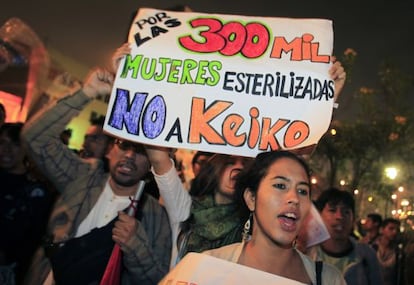Peru opens registry on ex-president Fujimori’s forced sterilization drive
Surgeries were used to control the rural population and avoid new generations of guerrillas

In a first, Peru has set up a public registry for victims who underwent forced sterilizations under a controversial family planning law introduced by President Alberto Fujimori during his final term in office (1995-2000).
The public prosecutor’s office has received more than 2,000 complaints and has registered about 44 deaths of women who took part in what was then called “voluntary contraceptive surgery.”
In 2011, the forced sterilization program became a major issue during the election
According to official figures, 272,028 sterilizations took place in Peru between 1990 and 2001.
The registry, which was announced on Friday, seeks “to identify a global range of persons affected” by Fujimori’s family planning law policy, in place from 1996 to 2000, while guaranteeing their legal and health rights.
In 1997, one obstetrician told US anthropologist Kimberly Theidon that when the anesthesia ran out after a long day’s session, officials shut the doors at the clinics so that those waiting in line wouldn’t hear the screams from the women undergoing the procedure.
Health workers were required to meet goals set out by Fujimori’s government. At least 147 women were sterilized over one two-day period.
Under the Peruvian executive order signed on Friday, victims will also have access to psychological treatment.
The Lima government took this decision to comply with an Inter-American Court of Human Rights ruling that stemmed from the case involving Mamérita Mestanza, a 33-year-old woman who died in 1998 after she was subjected to a sterilization procedure in Encañada, Cajamarca province. Her family went before the court in 1999.
Peru agreed to investigate and punish all those responsible for the sterilization program, including politicians.
But Ana María Vidal, a lawyer who represents a group of victims, said that the new rules do not seek to provide “symbolic recognition or compensation,” which should be the country’s obligation under regional jurisprudence. Nevertheless, she said it was “the first step the government has taken to recognize its obligation to help women affected by a public policy that was introduced at the highest levels of government.”
In 2011, the forced sterilization program became a major issue during the election, when now-President Ollanta Humala mentioned it in a debate with Keiko Fujimori – Alberto Fujimori’s daughter, who lost the race.
In a 2014 book, Theidon said that forced sterilizations were not just used to control the population in poor rural areas – they were also used as a part of a “surgical war against poor women” to ensure they did not raise children who would later join the Shining Path guerrilla insurgency.
English version by Martin Delfin







































